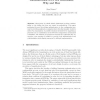Free Online Productivity Tools
i2Speak
i2Symbol
i2OCR
iTex2Img
iWeb2Print
iWeb2Shot
i2Type
iPdf2Split
iPdf2Merge
i2Bopomofo
i2Arabic
i2Style
i2Image
i2PDF
iLatex2Rtf
Sci2ools
ARC
2007
Springer
2007
Springer
Authentication of FPGA Bitstreams: Why and How
Abstract. Encryption of volatile FPGA bitstreams provides confidentiality to the design but does not ensure its authenticity. This paper motivates the need for adding authentication to the configuration process by providing application examples where this functionality would be useful. An examination of possible solutions is followed by suggesting a practical one in consideration of the FPGA’s configuration environment constraints. The solution proposed here involves two symmetric-key encryption cores running in parallel to provide both authentication and confidentiality while sharing resources for efficient implementation.
ARC 2007 | FPGA’s Configuration Environment | Hardware | Symmetric-key Encryption Cores | Volatile Fpga Bitstreams |
| Added | 07 Jun 2010 |
| Updated | 07 Jun 2010 |
| Type | Conference |
| Year | 2007 |
| Where | ARC |
| Authors | Saar Drimer |
Comments (0)

